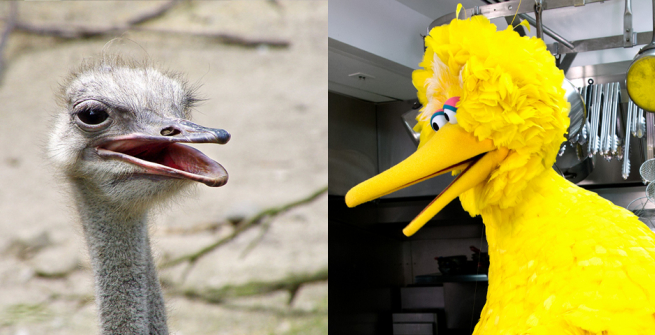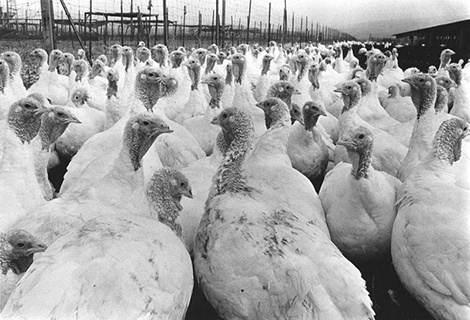Ostriches versus Turkeys. That age-old problem. (Is it? Well, for this blog post, the answer is yes). Which big bird do we Angelenos love more? And I'm not talking just in the looks department; both make for good eating.
Ostriches were brought to North America from Africa in the 1880s. Southern California got its first flock in 1883 when English naturalist Charles Sketchley opened a farm near Anaheim. In 1885, Sketchley partnered with landowner Griffith J. Griffith and moved the herd to Griffith's Rancho Los Feliz—now Griffith Park's Crystal Springs picnic area. Edward Cawston came next in 1886; he planned to cash in on the popularity of ostrich feathers as fashion accessories by cutting out the middlemen and raising his birds. "Shipping 50 birds via ship from South Africa to Galveston, Texas, Cawston traveled alongside the ostriches that had to endure 'a treacherous train journey' to South Pasadena. Only 18 of the original 50 animals survived." Cawston took the losses on the beak, and eventually grew the flock to 100 on his 9-acre farm in South Pasadena.

Also popular was the Los Angeles Ostrich Farm, which opened in 1906 next to the California Alligator Farm in East Los Angeles. By 1910 at the height of the craze, Southern California boasted ten ostrich farms. Eventually, Angelenos found other things to do than hang out with giant angry bi-pedal birds. Cawston’s farm closed in the mid-1930s, and the last to close, in 1953, was the Ostrich Farm in Lincoln Heights.
Almost a hundred years after the first ostrich farms appeared in America, the ostrich industry was briefly revived in the 1980s when "an American embargo interrupted the importation of ostrich leather and disrupted the American leather industry. As a small American flock was being grown and processed, it was discovered that ostriches produce red meat that mimics beef, but with significantly lower fat and cholesterol. As Americans were becoming more health-conscious and aware of the importance of a healthy diet, the expected demand for such healthy meat became the driving force of the industry in addition to the leather." Ostrich is considered an exotic meat, but can still be found locally for consumption.
Turkeys are native to North America and have been here for millennia. They come in a few varieties, some flying some not, including wild, domesticated, and ocellated turkey, found in the forests of the Yucatán Peninsula. (Fun fact, California once had its own variety; the Californian turkey. It was indigenous to the Pleistocene and early Holocene eras of California. It became extinct about 10,000 years ago. Thanks, Wikipedia!)
Turkeys, without all the ostrich hoopla, were also cultivated for their feathers. They have been used in the traditional regalia of many Native American tribes, particularly the feathered cloaks of eastern Woodland Indians like the Wampanoag (the tribe represented at the first Thanksgiving), as well as tribes in the Southeastern US.
Their plumage was used to decorate ceremonial clothing, headdresses, wands, and for arrows and whistles which were fashioned from turkey wing bones. Turkey feathers were sometimes used interchangeably with eagle feathers, or dyed to look like them, and could be found alongside duck and swan feathers. The turkey is also seen as a spirit animal and is closely associated with honoring nature and the Earth.
Eventually people came around to eat them as well; their docile nature and larger size (and general deliciousness) made for an excellent protein source. And, unlike chickens, goats, and cows, there was no other need to keep them alive for byproducts such as eggs, milk, and cheese.
Please enjoy the pictures of ostriches and turkeys from our photo collection and decide for yourself, which is the better bird!












